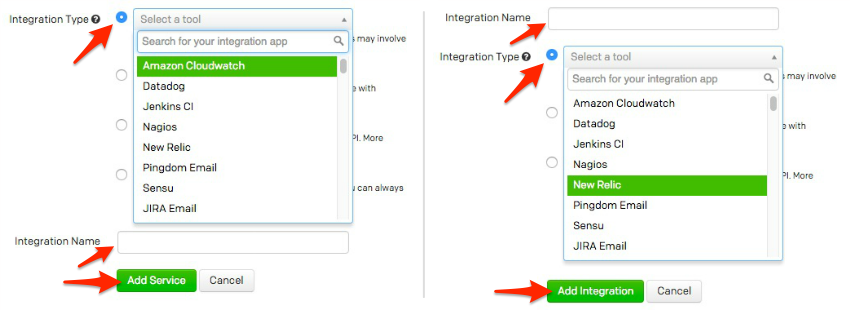Start Using PagerDuty Today
Try PagerDuty free for 14 days — no credit card required.
Monit is a small Open Source program for managing and monitoring Unix systems and services. Monit is relatively easy to install and configure while still being flexible for advanced users. Monit can be integrated with PagerDuty via both the generic email and the API integrations however, this guide will cover using the API. The email integration is explained below in the FAQ. If you run into any problems with the integration, please feel free to contact us.
If you are creating a new service for your integration, click +Add New Service.
If you are adding your integration to an existing service, click the name of the service you want to add the integration to. Then click the Integrations tab and click the +New Integration button.
If you are creating a new service for your integration, in General Settings, enter a Name for your new service. Then, in Incident Settings, specify the Escalation Policy, Notification Urgency, and Incident Behavior for your new service.


Install the PagerDuty Python library:
Open a terminal on the server and run the command pip install pagerduty to automatically download and install the Python library.
Install the PagerDuty-Monit scripts:
wget https://raw.githubusercontent.com/pinterest/pagerduty-monit/master/pagerduty-trigger
wget https://raw.githubusercontent.com/pinterest/pagerduty-monit/master/pagerduty-resolve

check process crond with pidfile /var/run/crond.pid
if does not exist for 3 cycles
then exec "/etc/monit/pagerduty-trigger crond"
else if succeeded for 3 cycles
then exec "/etc/monit/pagerduty-resolve crond"/etc/init.d/monit restart or monit reload.Test the integration:
Depending on what you are monitoring for and how you’ve configured Monit to react to the event, you may be able to simply turn off the service to trigger an incident. In the above configuration example `/etc/init.d/crond stop` will trigger an incident if the service is down for 3 consecutive checks.
You certainly can, you’d just need to have another copy of the ‘pagerduty-trigger’ and ‘pagerduty-resolve’ files with different names and service keys in each one. From there, you’d just modify the check stanza so it executes the correct script.
Yes! Issues resolved in Monit will update PagerDuty however, resolving things in PagerDuty does not fix them within Monit.
The configuration settings for using a mail server with Monit can be found here. You’d need to have a mailserver such as Exim or Sendmail installed to send the email out.
The PagerDuty Python library was likely installed at a different location on your system, such as /usr/bin/pagerduty. You can determine the correct path by running the command which pagerduty:
Simply run a find and replace in the pagerduty-trigger and pagerduty-resolve files to update /usr/local/bin/pagerduty with the location of the PagerDuty Python library on your system.
Try PagerDuty free for 14 days — no credit card required.